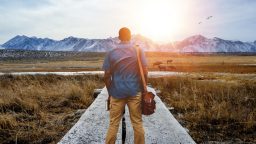Mountain climbing is one of the most exhilarating and rewarding outdoor activities you can take on. Whether you’re drawn to the challenge, the breathtaking views, or simply the desire to push your physical limits, climbing is an experience that’s unlike any other. But if you’re new to the sport, it can also seem daunting at first. Fortunately, getting started with mountain climbing doesn’t require years of training or fancy gear. With the right guidance and a little preparation, you can begin your climbing journey confidently. Here’s everything you need to know to start mountain climbing as a beginner.
- Start with the Basics: Understanding the Different Types of Climbing
Mountain climbing encompasses several different disciplines, and it’s important to understand the distinctions before you begin. As a beginner, you may want to start with one of the more accessible types of climbing:
- Hiking: Often considered a form of „mountain climbing lite,” hiking involves walking on trails that lead up mountains, hills, or ridges. While hiking can get steep and challenging, it’s usually less technical than actual rock climbing.
- Rock Climbing: This involves scaling rock faces using climbing holds, ropes, and technical gear. It’s physically demanding and requires some skill, but you can start with indoor gyms to practice before moving outdoors.
- Mountaineering: This is a combination of hiking, trekking, and climbing that usually involves ascending a mountain peak. It may require additional skills like ice climbing or the use of crampons and ice axes.
As a beginner, hiking or rock climbing indoors might be your best starting point. This will allow you to get a feel for the sport before progressing to more challenging forms of climbing.
- Get the Right Gear
The gear you use for mountain climbing will depend on the type of climbing you’re doing, but some basic equipment is necessary no matter what. For a beginner, it’s best to start with the essentials and gradually add more items as you progress:
- Climbing Shoes: A good pair of climbing shoes is essential, particularly for rock climbing. They should fit snugly to give you maximum control when scaling surfaces.
- Clothing: Wear moisture-wicking layers to keep your body temperature stable. In cold conditions, you’ll need warm layers, and in warmer conditions, lightweight and breathable clothes are best.
- Helmet: Protect your head with a helmet to guard against falling rocks or debris, especially when rock climbing.
- Climbing Harness: If you’re taking on rock climbing or mountaineering, a harness is essential for securing yourself to ropes and other safety equipment.
- Gloves: In more advanced mountain climbing, gloves will protect your hands from the cold and abrasions while handling ropes or ice axes.
If you’re unsure of where to start, many climbing gyms or outdoor equipment stores offer rentals, so you can try out gear before committing to buying your own.
- Consider Taking a Class or Hiring a Guide
While it’s possible to teach yourself the basics of mountain climbing, it’s highly recommended that beginners take a class or hire a guide for their first few outings. A professional instructor can teach you important techniques, such as how to belay, rappel, and safely use climbing equipment.
Guided tours also offer the benefit of having someone with local knowledge, especially if you’re heading to a more remote or technical mountain. Whether you’re learning how to climb indoors at a gym or heading outdoors to hike up a mountain, investing in a class or guide is a great way to boost your confidence and skill level.
- Start Small: Choose the Right Mountain
It might be tempting to aim for a challenging summit, but as a beginner, it’s essential to start with smaller, less demanding mountains. Begin by researching beginner-friendly mountains or hiking trails that are well-known for being accessible and safe for newcomers.
Some great options for beginners include:
- Snowdonia National Park (Wales): Known for its picturesque landscapes and manageable peaks like Mount Snowdon, it offers plenty of beginner hiking trails.
- Ben Nevis (Scotland): The UK’s highest peak, Ben Nevis, is a popular spot for novice hikers and climbers, with a well-trodden path to the summit.
- The Lake District (England): Home to several low-level peaks with varied routes suitable for beginners and intermediate climbers alike.
For rock climbing, look for easy to moderate climbing routes, or head to indoor climbing walls to build your confidence before moving outside.
- Focus on Building Strength and Stamina
Mountain climbing requires both physical strength and mental resilience. Before you hit the mountains, it’s a good idea to focus on building your physical fitness. This includes strengthening your upper body (for climbing), core (for balance), and legs (for hiking and endurance).
Here are some exercises that will help you get into shape:
- Cardio: Hiking and climbing are physically demanding, so aerobic exercises like running, swimming, or cycling can help improve your endurance.
- Strength Training: Weight training focusing on the arms, legs, and core will help you climb and hike more effectively.
- Flexibility: Stretching and yoga will improve your balance, flexibility, and agility—important skills for climbing.
Additionally, work on mental toughness. Mountain climbing often involves pushing through discomfort and staying calm under pressure, so practising mental focus through mindfulness techniques can be incredibly helpful.
- Know the Risks and Be Prepared
Mountain climbing, especially when you’re outdoors, involves certain risks. Understanding these risks and preparing for them is crucial to staying safe. Here are a few things to consider:
- Weather: Always check the forecast before your climb and be prepared for changes in weather conditions. Mountain weather can shift quickly, so be ready for rain, wind, or sudden temperature drops.
- Altitude: When climbing higher altitudes, you might face altitude sickness. Take it slow and allow your body to acclimatise.
- Safety: Always climb with a buddy when possible, and carry a first-aid kit, a map, compass, or GPS device, and enough food and water for your journey.
- Enjoy the Journey
Mountain climbing is as much about the journey as it is about reaching the summit. Enjoy the process of getting fitter, learning new skills, and discovering new landscapes. While the challenge of climbing a mountain can be tough, the sense of accomplishment you feel when you reach the top is unparalleled. And even if you don’t summit, the experience of being outdoors and pushing your limits is worth every step.
Conclusion
Starting mountain climbing as a beginner doesn’t have to be intimidating. By taking the right steps—whether it’s choosing the right type of climbing, investing in proper gear, or taking a class—you can set yourself up for success and begin your journey safely. Remember to start small, build your fitness, and enjoy every part of the adventure. Mountain climbing is a rewarding and enriching experience that can take you to new heights, both physically and mentally. So, lace up those boots, take a deep breath, and start exploring the world’s mountains one climb at a time.





